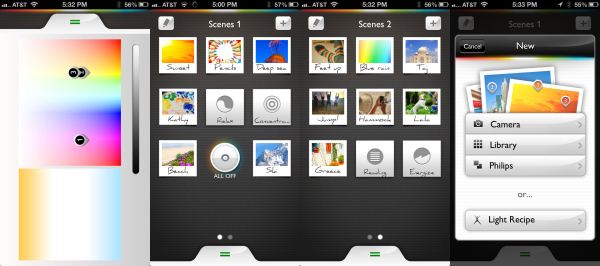Philips Hue: Automated Home Lighting Gets Colorful
by Ashu Joshi on March 1, 2013 12:50 AM EST- Posted in
- Gadgets
- Home Automation
- Philips
- Hue
- Lighting
The Philips Hue Experience
Subjectively, I find the light from the Hue system looks beautiful; it’s also fun watching the different combinations (or scenes) pre-programmed into the app. If not for the $60 per Connected Bulb price, I would seriously consider getting more lights and having them all over my home. I’m not going to try and reproduce pictures and videos showing what Hue looks like in action, as you can experience that on MeetHue.com, but it definitely creates a different feel than having standard lights.
There are many pre-programmed scenes that come with the app (and others are available online, including user-created scenes). If you can’t find something you like, however, you can easily edit existing scenes or create new ones. The app gives you the ability to set both the brightness and the color of each bulb and then save that setting, and you can group these settings so that, for example, your living room light settings are separate from your bedroom light settings.
There is no observable latency when controlling the lights while on the home network. The bulbs respond to changes with barely perceptible lag when being controlled from the smartphone. They ramp up/down to the specified brightness level and you can see the gradual change of color or brightness. This makes sense as an abrupt change would make for a very harsh experience.
Once you leave the home network and control the lights over the Internet, the lag/latency increases to around 8-12 seconds. I was able to simulate this by turning off my phone’s WiFi connection and using its data connection, but however you do it the results should be similar. When you’re remotely managing the lighting, there are a few extra steps that account for the delay, as communication has to go through a server that then has to send commands over the Internet to your Hue Bridge. Now you have to use the app to connect to the MeetHue portal (which takes around 8-10 seconds initially). Once connected the bulbs respond to changes to a new scene or to turn on/off in around 5-8 seconds. Depending on the protocol used and the server load, this could account for the majority of the lag, but it’s worth noting that instant responses to remote changes in lighting levels don’t really matter since you’re not physically there to see what’s happening anyway.











94 Comments
View All Comments
darkcrayon - Wednesday, March 6, 2013 - link
I think the main purpose for this product is the remote control and ability to dynamically adjust the color. "Fun" as it were. The energy savings over incandescent (if anyone still uses those) is more of a bonus. I have a couple of them in floor lamps (with the plastic "bowl" at the top) and they work fine in those, not ultra bright but bright enough for my needs. And again, a lot of fun to be able to bathe my room in blue light leaning back listening to music or what have you.Drizzt321 - Friday, March 1, 2013 - link
Given that I have a Pre3 with webOS, NOBODY has an App for my device. So can I set these up without the app? Is there a web interface that I can use? Or would I have to rely on the hacked HTTP control commands?JarredWalton - Friday, March 1, 2013 - link
If you don't have a smartphone, tablet, or iPod Touch, it appears you'd have to go the hacked support route. Ashu can correct me if I'm wrong. :-)darkcrayon - Wednesday, March 6, 2013 - link
Yeah, you'd have to get a hacked app running on a computer with which you could create a web interface... I did this with my set, there is a handy perl script out called Huepl that lets you control most aspects of the lights from command line commands, so I made a web interface "remote" so i could control the lights easily from any device (the phillips app lets you finely adjust colors and color sets but it isn't as handy and of course it doesn't run natively on a desktop computer).kmmatney - Friday, March 1, 2013 - link
wholly crap, that a lot of lumens...I'm not sure I have any place to put a 2800 Lumen bulb (and it doesn't look like you can dim it) except in my garage. I guess if you only have 1 or 2 light fixtures in a room it would work.Ninhalem - Friday, March 1, 2013 - link
http://arstechnica.com/gadgets/2012/11/in-living-c...Digital Deus - Friday, March 1, 2013 - link
There needs to be an easy way to locally control the light, either at the lamp or on the wall. Having to use an app all the time just to turn on the kitchen light is a non starter.degobah77 - Friday, March 1, 2013 - link
You can still turn on the lights by flipping the switch as you normally would. You just won't be able to dim it or change colors, it acts as a normal bulb at that point. Then as soon as you activate the app, you're in complete control again.Digital Deus - Friday, March 1, 2013 - link
The light always needs to have power. When you turn it off using the switch it's useless as a remote controlled light. The wall or lamp switch needs to be ZigBee.degobah77 - Friday, March 1, 2013 - link
That's what I just said. If you need the immediate gratification of lighting, then you can just flip the switch on and use it as a regular old bulb. If not, just take the 10 seconds to use the app and perform the same action, but with more options. Not sure what the issue is here.